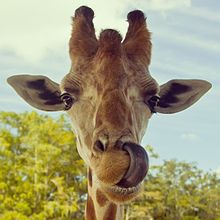| This article needs additional citations for verification. Please help improve this article by adding citations to reliable sources. Unsourced material may be challenged and removed. Find sources: "Prehensility" – news · newspapers · books · scholar · JSTOR (December 2009) (Learn how and when to remove this message) |

Prehensility is the quality of an appendage or organ that has adapted for grasping or holding. The word is derived from the Latin term prehendere, meaning "to grasp". The ability to grasp is likely derived from a number of different origins. The most common are tree-climbing and the need to manipulate food.

Examples
| This section is in list format but may read better as prose. You can help by converting this section, if appropriate. Editing help is available. (October 2018) |
Appendages that can become prehensile include:
| Hands and feet |
| |
| Tails |
| |
| Tongue |
|
|
| Nose |
| |
| Lip or lips |
| |
| Tentacles |
| |
Uses
Prehensility affords animals a great natural advantage in manipulating their environment for feeding, climbing, digging, and defense. It enables many animals, such as primates, to use tools to complete tasks that would otherwise be impossible without highly specialized anatomy. For example, chimpanzees have the ability to use sticks to obtain termites and grubs in a manner similar to human fishing. However, not all prehensile organs are applied to tool use; the giraffe tongue, for instance, is instead used in feeding and self-cleaning.
See also
References
- Böhmer, Christine; Fabre, Anne-Claire; Taverne, Maxime; Herbin, Marc; Peigné, Stéphane; Herrel, Anthony (2019-04-27). "Functional relationship between myology and ecology in carnivores: do forelimb muscles reflect adaptations to prehension?". Biological Journal of the Linnean Society. 127 (3): 661–680. doi:10.1093/biolinnean/blz036. ISSN 0024-4066.
- Silvio Renesto, Justin A.; Spielmann, Spencer G. Lucas; Spagnoli, Giorgio Tarditi (2010). "The taxonomy and paleobiology of the Late Triassic (Carnian-Norian: Adamanian-Apachean) drepanosaurs (Diapsida: Archosauromorpha: Drepanosauromorpha)". New Mexico Museum of Natural History and Science Bulletin. 46: 1–81.
- Fröbisch, Jörg; Reisz, Robert R. (2009). "The Late Permian herbivore Suminia and the early evolution of arboreality in terrestrial vertebrate ecosystems". Proceedings of the Royal Society B. 276 (1673) (Online first ed.): 3611–3618. doi:10.1098/rspb.2009.0911. PMC 2817304. PMID 19640883.